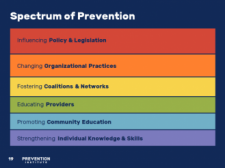Together, we can change norms to prevent sexual violence and harassment

"The still-unfolding stories—across all industries and sectors—only confirm what too many of us already know: sexual violence and harassment are pervasive at all levels of our society.
A few years ago, we identified a set of norms that increase the risk of sexual violence. Norms shape our beliefs, attitudes, and behaviors, and influence our sense of what’s acceptable and not acceptable within a community or society at large. When we understand norms as a key factor that shapes the likelihood of sexual violence and harassment, we can see more clearly what needs to change and which strategies will be effective. The norms that increase the risk of sexual violence and harassment promote rigid gender norms that associate masculinity with control and femininity with compliance; abuse of power over others; aggression and violence; and the expectation that sexual violence should be treated as a private problem, not a public concern.
Here are some ways these norms manifest themselves in our society:
- Harmful norms about masculinity: Rigid gender norms about masculinity that promote domination, control, and risk-taking are expressed in workplaces and other settings as an expectation that men and others will push rather than respect boundaries, e.g., “No means try harder.”
- Harmful norms about femininity: Rigid gender norms about femininity that promote compliance and sacrifice show up in the workplace as an expectation that women and others will accept and even blame themselves for boundary violations, e.g., “Go along to get along.”
- Norms that support abuse of power: Our society places a lot of value on claiming and maintaining power, which too often gets expressed as power over other people. Harmful norms about power promote exploitation by people with more power (i.e., adults, bosses, documented residents, and citizens) of those with less power (children, employees, undocumented residents), e.g., “What do you expect? That’s what strong leaders do.”
- Tolerance of aggression and violence: Violence is pervasive in our society and is often deployed as a mechanism for addressing conflict or resolving problems. Norms that promote tolerance for aggression and violence can be seen in behaviors that excuse people who act violently, e.g., “He’s the star athlete of the school, and we need to let him play,” and blame victims, e.g., “Why was she there? Why did she wait so long to say anything?”
- Sexual violence as a private matter, not a public concern: A healthy respect for privacy can turn into harmful inaction when sexual violence is erroneously conflated with private sexuality. In schools, workplaces, and other settings, peers and people in authority who adhere to this norm turn away from what’s happening, e.g., “It’s none of my business.”
These and other norms interact with and exacerbate one another, especially when multiple forms of power inequity coincide—for instance, in the service industry, where women, people of color, people with low incomes, and people with undocumented immigration status are overrepresented."

